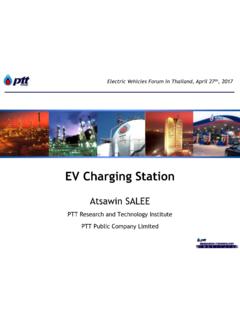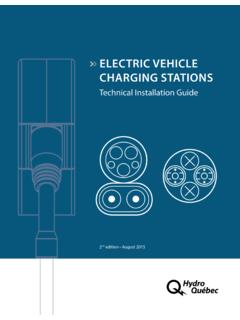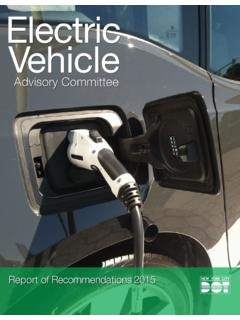Transcription of Low Emission Topic Note 1 Provision of EV charging …
1 Version (12 December 2013). Low Emission Topic Note 1. Provision of EV charging points via planning agreements Prepared by Green Sphere on behalf of the Low Emission Partnership Authors: Liz Bates and Rob Pilling Summary i) This note provides a short review of current policy and practice on Provision of EV charging points via planning agreements. It covers: - national policy context - General approach on local policies and guidance - Role of air quality specialists - Qualifying developments - Setting levels of Provision - Technical specification of charging infrastructure ii) It also identifies some development issues and considerations, including around: - Ease of policy adoption - Setting levels of Provision - Risks associated with technical specification - Approach towards strategic network development iii) The appendices provide specific examples of current practice.
2 Iv) The review draws on published and draft policies/guidance; and also on informal consultation with key practitioners, including: Bradford MBC, Sefton MBC, Mid Devon Council, West Midlands Low Emissions Towns and Cities Programme (LETCP), City of York Council, Sussex Council, Leeds City Council and Future Transport Systems. v) Topic notes provide rapid communication of outputs from review and development work undertaken by the Partnership. Further notes will be published as information becomes available. Current work includes: - Wider review of emerging practice on low Emission planning policies and agreements - Development of selected case studies on low Emission infrastructure development - Review/sign-posting of guidance on technical specification of EV requirements vi) For more information on current work and publication time table please contact The Partnership would welcome feedback and questions relating to any aspect of this first Topic note as well as on wider related issues.
3 Low Emission Partnership Version (12 December 2013). 1 General Approach national Policy Local Authorities need to plan for an increase in demand for electric vehicle recharging infrastructure over the coming years. Planning policy and development management provide important delivery mechanisms. The Office for Low Emission Vehicles (OLEV) have set out a UK strategy to ensure that by 2050. nearly every new vehicle purchased in the UK will be an ultra-low Emission vehicle . Pure electric and plug-in hybrid vehicles are therefore anticipated to take an increasing share of the new car and van market over the next 40 years. The national Planning Policy Framework states (para35) that Plans should protect and exploit opportunities for the use of sustainable transport modes for the movement of goods or people.
4 Therefore, developments should be located and designed where practical to [ ] incorporate facilities for charging plug-in and other ultra-low Emission vehicles'. Local Policies and Guidance Many local authorities already obtain electric vehicle recharging points through the planning system. Their approach generally takes one of the forms listed below and the nature/level of Provision achieved does not appear to be dependent on the exact route followed (note that, in many cases EV charging points are just one of a number of different types of low Emission mitigation measures being sort through the same guidance note): - Development and adoption of formal planning policy originally in the form of SPDs or SPGs but following changes to the planning system are being revised to become Development Management Policies (DMP) or similar ( Mid-Devon).
5 - Development and adoption of local planning guidance notes ( Bradford, York). - Changes to parking policy requirements on new developments (sometimes combined with a wider formal planning policy / guidance note) ( Sefton, Dudley). - Requirements in travel planning policies ( Leeds). In general, EV planning requirements entail Provision of one or a combination of: - on-site charging infrastructure - local charging infrastructure ( nearby but off-site). - a financial contribution towards developing a wider local strategic ev infrastructure Different approaches are followed to establish requirements for a given site: - Standard Provision based on pre-specified site characteristics ( development size or number of parking spaces).
6 - Requirement on a developer to propose mitigation based on an Emission assessment, including potentially Provision of EV infrastructure. - Flexible requirements based on case by case negotiation between planning authority and the developer. - Provision determined with reference to a strategic EV infrastructure plan. Some authorities have also identified opportunities to broker EV Provision at the point of development or afterwards, via non-planning routes'. This can help to reduce overall burden on the developer and/or to increase the overall level of Provision that it is possible to achieve at a given site. Low Emission Partnership Version (12 December 2013). 2 Common Principles Role of air quality officers This is a relatively new area in the field of planning.
7 Successful implementation of LES. planning guidance for the Provision of EV charging points (and potentially other mitigation measures) requires the support of air quality officers to provide air quality evidence to support planning policy. Air quality officers may also contribute to or drive: - development of policy hooks in core strategies or other core planning documents - drafting and consultation on guidance notes - training of development control colleagues on implementation of the guidance - advice on review of specific planning applications and developer proposals Developers are also largely new to this area and may need support from LA planning and air quality staff to comply with new requirements.
8 In some cases detailed discussions and extensive negotiations with developers and consultants will be required. Qualifying Developments Many different types of development are suitable for obtaining either EV charging infrastructure or financial contributions towards a wider charging network. The most common are: - Commercial, business and retail sites - Residential developments - New domestic garages Standard Provision Amongst those Authorities who have produced guidance the greatest consistency in EV. charging requirements is for new housing developments, irrespective of size: - one EV charging point per residential dwelling with dedicated off street parking - one EV charging point per 10% of undedicated parking spaces (or a minimum of 1).
9 There is some variation in the definition of off-street' parking with some authorities considering this to be any form of driveway (hence requiring an external charging point) whilst others limit the requirement to those properties with garages (internal charging point). Not all Authorities request EV charging points for non-dedicated residential parking spaces. For other types of development ( commercial, retail and industrial), requirements of around 10% is common, though there is greater variation here in the detail, some include: - an option to deliver in two phases ( 5% then another 5%). - additional criteria such as numbers of rooms or retail area to refine the specification. See appendices and references list for current practice examples.
10 Low Emission Partnership Version (12 December 2013). Emission Assessments Some Authorities do not separate EV charging from other mitigation measures nor have standard requirements relating to the type / size of the development. Instead they require developers to estimate the emissions impact of the site and propose appropriate mitigation. In Mid-Devon a proposed new approach is to require the developer to calculate and minimise residual transport emissions (using a recognised tool such as LET) from the development once mitigation measures (potentially including Provision of charging points) have been applied. A similar situation exists in Sussex where those developments needing to advance to an Emission assessment stage are required to demonstrate that they have mitigated the residual emissions using measures from a given pick' list (in the case of non-major developments within the proximity of an AQMA an Emission assessment is not required but the local authority retains the right to condition what it considers to be appropriate mitigation).




